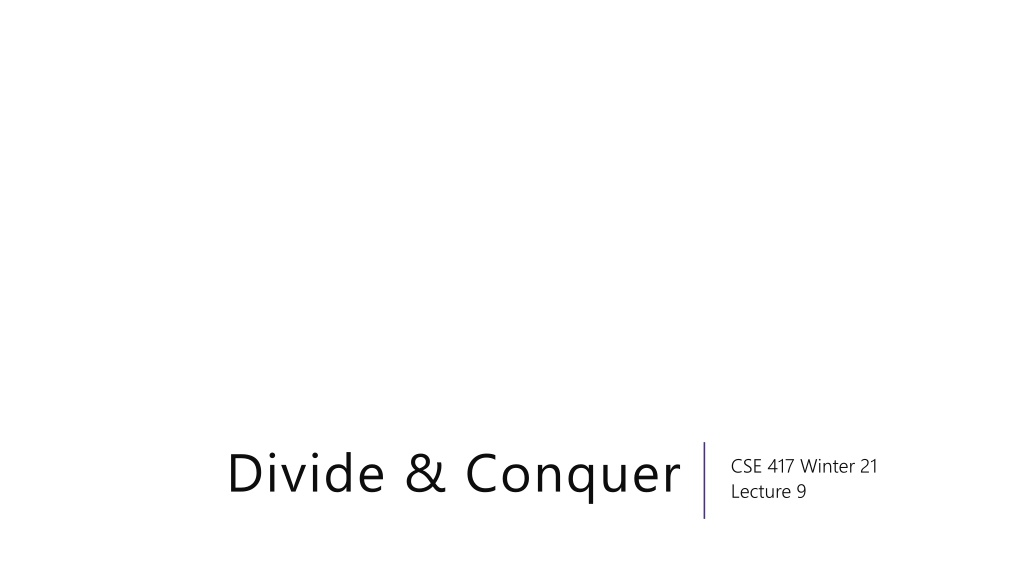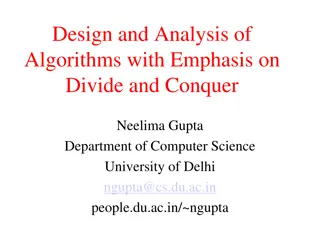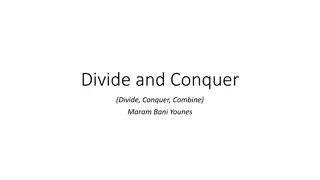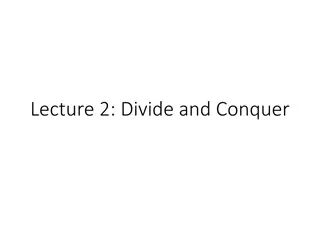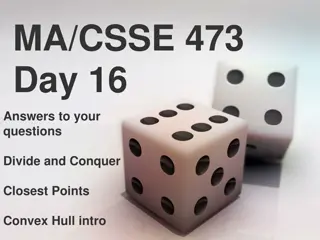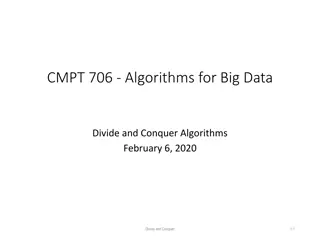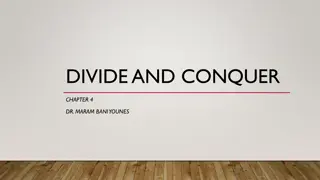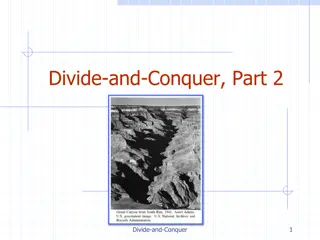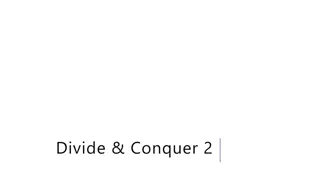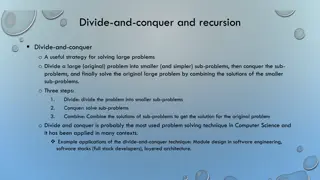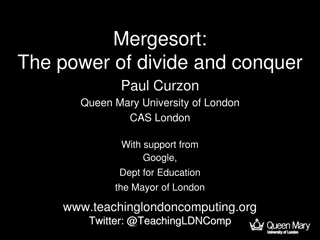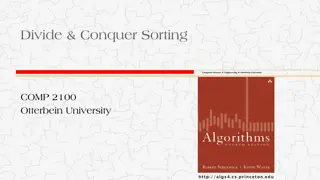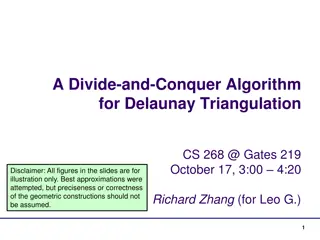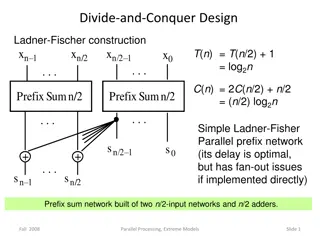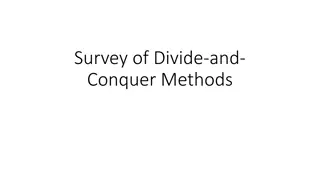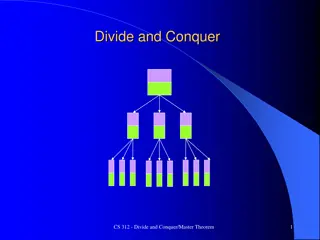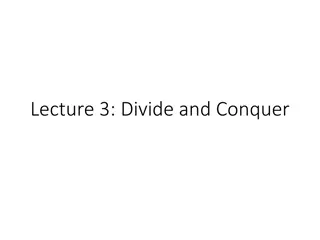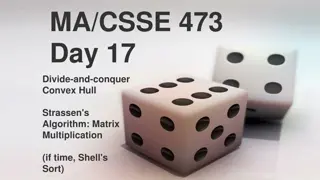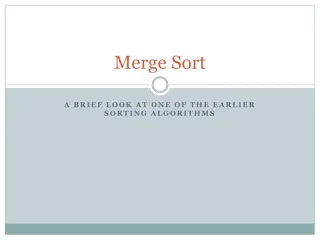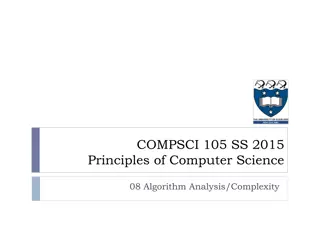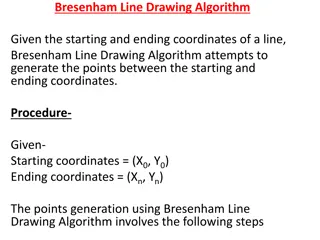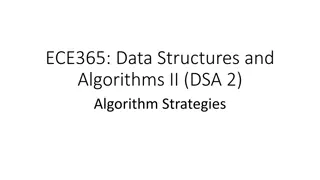Exploring Divide and Conquer Paradigm in Algorithm Design
Discover the Divide and Conquer approach in algorithm design through concepts like Merge Sort and Counting Inversions. Learn how to split instances into subparts, solve them recursively, and combine the answers to optimize algorithm efficiency.
Download Presentation

Please find below an Image/Link to download the presentation.
The content on the website is provided AS IS for your information and personal use only. It may not be sold, licensed, or shared on other websites without obtaining consent from the author. Download presentation by click this link. If you encounter any issues during the download, it is possible that the publisher has removed the file from their server.
E N D
Presentation Transcript
Divide & Conquer CSE 417 Winter 21 Lecture 9
Divide & Conquer Algorithm Design Paradigm 1. Divide instance into subparts. 2. Solve the parts recursively. 3. Conquer by combining the answers
Merge Sort https://www.youtube.com/watch?v=XaqR3G_NVoo Divide 0 1 2 3 4 5 6 7 8 9 8 2 91 22 57 1 10 6 7 4 5 6 7 8 9 0 1 2 3 4 1 10 6 7 4 8 2 91 22 57 Sort the pieces through the magic of recursion magic Combine 5 6 7 8 9 0 1 2 3 4 1 4 6 7 10 2 8 22 57 91 0 1 2 3 4 5 6 7 8 9 1 2 4 6 7 8 10 22 57 91 CSE 373 19 SU - ROBBIE WEBER 3
0 1 2 3 4 Merge Sort 8 2 57 91 22 0 1 0 1 2 8 2 57 91 22 mergeSort(input) { if (input.length == 1) return else smallerHalf = mergeSort(new [0, ..., mid]) largerHalf = mergeSort(new [mid + 1, ...]) return merge(smallerHalf, largerHalf) } 0 1 0 0 0 91 22 2 57 8 0 0 22 91 0 1 1 if n<= 1 2T(n/2) + n otherwise = ?(?log?) Worst case runtime? T(n) = 22 91 Best case runtime? Same 0 1 0 1 2 2 8 22 57 91 Average runtime? Same Yes Stable? 0 1 2 3 4 2 8 22 57 91 No In-place? CSE 373 19 SU - ROBBIE WEBER 4
Counting Inversions Given an array, ?, determine how unsorted it is, by counting number of inversions: Inversion: pair ?,? such that ? < ? but ? ? > ?[?] 0 1 2 3 4 8 2 91 22 57 0,1 , 2,3 , and (2,4) are inversions Intuitively, how many adjacent swaps to fully sort. Why? Tell how different two lists are (e.g. tell if someone s opinion is an outlier, or if two people have similar preferences)
Counting Inversions Given an array, ?, determine how unsorted it is: Find the number of pairs ?,? such that ? < ? but ? ? > ?[?] 0 1 2 3 4 8 2 91 22 57 Visualization: overlaps correspond to inversions (needed swaps) 0 1 2 3 4 2 8 22 57 91
Counting Inversions What s the first idea that comes to mind (don t try to divide and conquer yet). Check every pair ?,? (?2) time. Goal: do better than (?2)
Divide & Conquer Inversions 1. Divide instance into subparts. 2. Solve the parts recursively. 3. Conquer by combining the answers 1. Split array in half (indices 0,? 2. Solve the parts recursively (gives all inversions in each half) 3. Combine the answers So do we just add? 2 1 and ? 2,? 1 )
Conquer Can t just add! 0 1 2 3 4 8 2 91 22 57 0 1 2 3 4 8 2 91 22 57
Conquer Kinds of ?,? Both, ?,? in left side counted by recursive call Both ?,? in right side counted by other recursive call ? in left side, ? in right side TODO ? in right side, ? in left side Can t have ? < ? no inversions here. Need to handle TODO. Then add together.
Inversions across the middle Fix some ? on the left side. How many ? on the right side form inversions? 0 1 2 3 4 8 2 91 22 57 So how do we find all the crossing inversions ? 2 elements, each checking ? 2others, so that s time (?2) to merge
Running Time ? 2 + ?2 if ? 2 ? ? = 2? 1 othwerwise Master Theorem says:
Master Theorem Given a recurrence of the following form, where ?,?,?, and ? are constants: ? 2 + ?2 if ? 2 ? ? = 2? ? if ? is at most some constant ? ? ? ? = 1 othwerwise ?? + ? ? otherwise Where ? ? is ?? ? ? ?? If then log?? < ? ? ? ??log? If then log?? = ? ? ? ?log?? If then log?? > ?
Running Time ? 2 + ? ?2 if ? 2 ? ? = 2? ? 1 othwerwise Master Theorem says: log22 = 1 < 2 So ?(?2) Not actually better than brute force.
Divide & Conquer Smarter In fact, all that divide & conquer did was rearrange doing anyway. We re still explicitly checking for every ?,? is ?,?an inversion? rearrange the work we were The trick to making divide & conquer efficient is to make it so that conquering is easier easier than just solving the whole problem.
Counting Across the Middle Fix some ? on the left side. How many ? on the right side form inversions? What would we do if the right hand side were sorted?
Counting the inversions 0 1 2 3 4 5 6 7 8 9 8 2 91 22 57 1 4 6 7 10 Inversions involving index 0: (0,5) (0,8) Inversions involving index 1: (1,5) Inversions involving index 4: [none]
Counting Across the Middle Fix some ? on the left side. How many ? on the right side form inversions? What would we do if the right hand side were sorted? Binary search! Time? O(log?)per element on the left side so ?(?log?) to combine
Analyze, round 2. ? 2 ? ? = 2? + ? ?log? if ? 2 ? 1 othwerwise Master Theorem says: log22 = 1 ?????
Master Theorem Given a recurrence of the following form, where ?,?,?, and ? are constants: ? 2 ? if ? is at most some constant ? ? = 2? + ? ?log? if ? 2 ? ? ? ? = ?? + ? ? otherwise ? 1 othwerwise Where ? ? is ?? ? ? ?? If then log?? < ? ? ? ??log? If then log?? = ? ? ? ?log?? If then log?? > ?
Pause Lets get some intuition ?(?log?) is closest to which of these: ?(?) ? ?1.1 ? ? ? ?(?2)
Pause Lets get some intuition ?(?log?) is closest to which of these: ?(?) ? ?1.1 So we d expect to get an answer between (?log?) and (?1.1log?), but closer to (?log?) ? ? ? ?(?2)
Master Theorem, v2 (?log2?) i.e. (? log ? log ? ) https://en.wikipedia.org/wiki/Master_theorem_(analysis_of_algorithms)
Counting Across the Middle So sort the array first! As a preprocessing step Then count the inversions. What s the problem? When you sort, the inversions disappear Ok, sort as part of the process.
Almost there int CountInversions(A, int start, int stop) inversions = 0 if(start >= stop) return 0 int midpoint = (stop-start)/2 + start inversions += CountInversions(A, start, midpoint) inversions += CountInversions(A, midpoint+1, end) sort(A, midpoint+1, end) for(int i=start; i <= midpoint; i++) int k = binarySearch(A, midpoint+1, end, i) inversions += k-(midpoint+1)+1 return inversions
Just a liiiiiittle better Sort the left subarray too! Can that help us? If ?,? is an inversion then ? + 1,? and ? + 2,?, and, ? inversions. Don t have to binary search every time, can just march down lists. 2 1,? are also
Sorted example 0 1 2 3 4 5 6 7 8 9 2 8 22 57 91 1 4 6 7 10 0,5 is an inversion. 1,5 , 2,5 , 3,5 ,(4,5) are too! Know everything we need to about index 5. (0,6) is not an inversion. 0,7 ,(0,9)aren t either. Know everything we need to about index 0. (1,6) is an inversion 2,6 , 3,6 ,(4,6) are too! Know everything we need to about index 6.
In general 0 1 2 3 4 5 6 7 8 9 2 8 22 57 91 1 4 6 7 10 In general: If (?,?) is an inversion, have (? If (?,?) is not an inversion, increase ?. 2 ?) inversions. Increase ?. Time to iterate? (?)
Does thislook familiar Having an arrow to a spot in two arrays, moving whichever is on the smaller value forward That s how merge from mergesort works! If we sort (by mergesort) and count inversions as we re merging that log factor. as we re merging we save Running time (n log n)
Final Pseudocode int CountInversions(A, int start, int stop) inversions = 0 if(start >= stop) return 0 int midpoint = (stop-start)/2 + start inversions += CountInversions(A, start, midpoint) inversions += CountInversions(A, midpoint+1, end) invsersions += mergeAndCount(A, start, stop) return inversions
int mergeAndCount(A, start, stop) int inv = 0 int[] temp = new int[A.length] int left=start; int mid=start+(stop-start)/2; int right=mid; int curr = start; while(left <= mid && right <= stop) if(A[left] < A [right]) temp[curr++] = left++; else temp[curr++] = right++; inv += (mid left)+1; while(left <= mid) temp[curr++] = left++ while(right <= mid) temp[curr++]=right++; inv += (mid left)+1; for(int i=start; i<=stop; i++) //copy back into A, now sorted A[i]=temp[i]; return inv For an actual implementation, think about how you re using temporary space. There are more efficient options than this one! Though you won t avoid (?) space.
Another divide and conquer Maximum subarray sum Given: an array of integers (positive and negative), find the indices that give the maximum contiguous subarray sum. 0 1 2 2 4 3 4 3 5 6 6 7 -3 -1 -10 -4 Sum: 8
Maximum Contiguous Subarray Sum Brute force: How many subarrays to check? (?2) How long does it take to check a subarray? If you keep track of partial sums, the overall algorithm can take (?2) time. Can we do better?
Maximum Contiguous Subarray Sum 1. Divide instance into subparts. 2. Solve the parts recursively. 3. Conquer by combining the answers 1. Split the array in half 2. Solve the parts recursively. 3. Just take the max?
Conquer 0 1 2 2 4 3 4 3 5 6 6 7 -3 -1 -10 -4 Subarrays that cross have to be handled Do we have to check all pairs ?,??
Conquer If the optimal subarray: is only on the left handled by the first recursive call. is only on the right handled by the second recursive call. crosses the middle TODO Do we have to check all pairs ?,?? 0 1 2 2 4 3 4 3 5 6 6 7 -3 -1 -10 -4
Crossing Subarrays Do we have to check all pairs ?,?? 0 1 2 2 4 3 4 3 5 6 6 7 -3 -1 -10 -4 ? 2 1 + ? ? 2 2 + + ? ? + ? ? 2+ ? ? 2+ 1 + ?[?] Sum is ? ?,? affect the sum. But they don t affect each other. Calculate them separately! separately!
Crossing Subarrays Do we have to check all pairs ?,?? 0 1 2 2 4 3 4 3 5 6 6 7 -3 -1 -10 -4 Best ?? Iterate with ? decreasing, find the maximum. ? = 1 has sum 5. Time to find ?? (?)
Crossing Subarrays Do we have to check all pairs ?,?? 0 1 2 2 4 3 4 3 5 6 6 7 -3 -1 -10 -4 Best ?? Iterate with ? increasing, find the maximum. j = 4 has sum 3. Time to find ?? (?)
Finishing the recursive call Overall: 0 1 2 2 4 3 4 3 5 6 6 7 -3 -1 -10 -4 Compare sums from recursive calls and ? ? + + ?[?], take max.
Running Time What does the conquer step do? Two separate (?) loops, then a constant time comparison. So ? 2 ? ? = 2? + ? if ? 2 1 otherwise Master Theorem says (?log?)
//returns array of length three: index of start, end of subarray, sum. MaxSubarraySum(int[] A, int left, int right) int mid = left + (right left) / 2 LeftResult = MaxSubarraySum(int[] A, left, mid); RightResult = MaxSubarraySum(int[] A, mid+1, right); //find Spanning option int sum=0; int maxSum= ; int bestRightInd=mid; int bestLeftInd=mid+1; int bestLeftSum=0; int bestRightSum=0; for(int i=mid+1; i<right; i++) sum+=A[i] if(sum > maxSum) bestRightInd=i; bestRightSum=sum for(int i=mid; i>left; i--) sum+=A[i] if(sum > maxSum) bestLeftInd=i; bestLeftSum=sum SpanResult = [bestLeftInd, bestRightInd, leftSum+rightSum] //return one with largest sum (i.e. largest final entry) return max of LeftResult, RightResult, SpanResult
